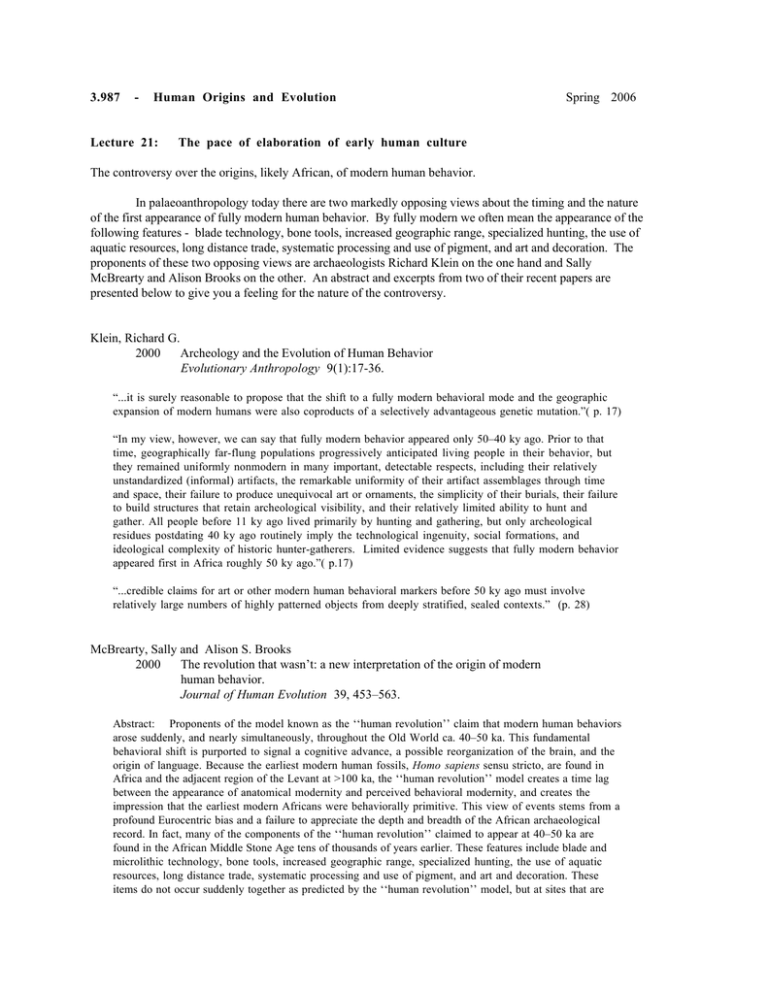Spring 2006
advertisement

3.987 - Human Origins and Evolution Lecture 21: Spring 2006 The pace of elaboration of early human culture The controversy over the origins, likely African, of modern human behavior. In palaeoanthropology today there are two markedly opposing views about the timing and the nature of the first appearance of fully modern human behavior. By fully modern we often mean the appearance of the following features - blade technology, bone tools, increased geographic range, specialized hunting, the use of aquatic resources, long distance trade, systematic processing and use of pigment, and art and decoration. The proponents of these two opposing views are archaeologists Richard Klein on the one hand and Sally McBrearty and Alison Brooks on the other. An abstract and excerpts from two of their recent papers are presented below to give you a feeling for the nature of the controversy. Klein, Richard G. 2000 Archeology and the Evolution of Human Behavior Evolutionary Anthropology 9(1):17-36. “...it is surely reasonable to propose that the shift to a fully modern behavioral mode and the geographic expansion of modern humans were also coproducts of a selectively advantageous genetic mutation.”( p. 17) “In my view, however, we can say that fully modern behavior appeared only 50–40 ky ago. Prior to that time, geographically far-flung populations progressively anticipated living people in their behavior, but they remained uniformly nonmodern in many important, detectable respects, including their relatively unstandardized (informal) artifacts, the remarkable uniformity of their artifact assemblages through time and space, their failure to produce unequivocal art or ornaments, the simplicity of their burials, their failure to build structures that retain archeological visibility, and their relatively limited ability to hunt and gather. All people before 11 ky ago lived primarily by hunting and gathering, but only archeological residues postdating 40 ky ago routinely imply the technological ingenuity, social formations, and ideological complexity of historic hunter-gatherers. Limited evidence suggests that fully modern behavior appeared first in Africa roughly 50 ky ago.”( p.17) “...credible claims for art or other modern human behavioral markers before 50 ky ago must involve relatively large numbers of highly patterned objects from deeply stratified, sealed contexts.” (p. 28) McBrearty, Sally and Alison S. Brooks 2000 The revolution that wasn’t: a new interpretation of the origin of modern human behavior. Journal of Human Evolution 39, 453–563. Abstract: Proponents of the model known as the ‘‘human revolution’’ claim that modern human behaviors arose suddenly, and nearly simultaneously, throughout the Old World ca. 40–50 ka. This fundamental behavioral shift is purported to signal a cognitive advance, a possible reorganization of the brain, and the origin of language. Because the earliest modern human fossils, Homo sapiens sensu stricto, are found in Africa and the adjacent region of the Levant at >100 ka, the ‘‘human revolution’’ model creates a time lag between the appearance of anatomical modernity and perceived behavioral modernity, and creates the impression that the earliest modern Africans were behaviorally primitive. This view of events stems from a profound Eurocentric bias and a failure to appreciate the depth and breadth of the African archaeological record. In fact, many of the components of the ‘‘human revolution’’ claimed to appear at 40–50 ka are found in the African Middle Stone Age tens of thousands of years earlier. These features include blade and microlithic technology, bone tools, increased geographic range, specialized hunting, the use of aquatic resources, long distance trade, systematic processing and use of pigment, and art and decoration. These items do not occur suddenly together as predicted by the ‘‘human revolution’’ model, but at sites that are widely separated in space and time. This suggests a gradual assembling of the package of modern human behaviors in Africa, and its later export to other regions of the Old World. The African Middle and early Late Pleistocene hominid fossil record is fairly continuous and in it can be recognized a number of probably distinct species that provide plausible ancestors for H. sapiens. The appearance of Middle Stone Age technology and the first signs of modern behavior coincide with the appearance of fossils that have been attributed to H. helmei, suggesting the behavior of H. helmei is distinct from that of earlier hominid species and quite similar to that of modern people. If on anatomical and behavioral grounds H. helmei is sunk into H. sapiens, the origin of our species is linked with the appearance of Middle Stone Age technology at 250–300 ka.






